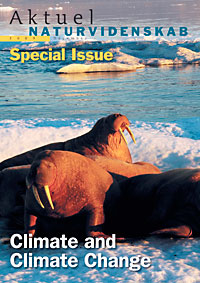Special Issue: Climate and climate change
Science is the only sensible foundation for the tough decisions facing the international community in terms of climate and climate change. However, in order to get everybody on the bandwagon it is of outmost importance that both politicians, trade and industry as well as the general public achieve a greater insight on the climate. Here we portray Danish climate research and climate knowledge through seven easily accessible articles written by the researchers themselves.
We will take you on a tour through the dwindling arctic ice, the intricate workings of CO2 as a greenhouse gas and the causes for natural climate variability and how to distinguish it from the anthropogenic changes taking place right now.
Enjoy the journey.
Download the Special Issue: Climate and Climate Change (pdf) 4.3 mb.
Opinion:
The Polar Regions are melting – together, we can change the climate (pdf)
We are at the point where the trend in climate change seems clear – the Polar Regions are melting, and in many cases the trends are following a worst-case scenario. Climate change is not only a polar issue, but a global issue, which requires global solutions.
By Sebastian H. Mernild
Climate research
Three roundabouts, summer and an ice age (pdf)
Climate variations on a long time scale such as ice ages, which come and go, can be linked to variations in the Earth’s movement around the Sun. Such natural climate variations set the scene for understanding the climate from a human perspective.
By Bjarne Siewertsen
Our climate out of order? (pdf)
By comparing data from geological studies to modern climate data, we believe that we are now able to distinguish between natural climate variations and anthropogenic climate change. The results indicate that the last 20-30 years of global warming cannot be explained by natural processes.
By Marit-Solveig Seidenkrantz, Antoon Kuijpers and Torben Schmith
Greenhouse gases - and their impact on the climate (pdf)
The greenhouse effect is the best understood and well mapped of the mechanisms that can lead to climate change.
By Eigil Kaas og Peter L. Langen
Is the ice burning? (pdf)
The impact of global climate change is commonly illustrated by the media with images of retreating and melting glaciers. But what is the state of the world’s glaciers, seen through the eyes of science?
By Kurt H. Kjær
Is ‘Tipping Point’ for the Greenland Ice Sheet approaching? (pdf)
Once an ice sheet starts to have continuously negative surface mass balance, the ice surface gradually decreases in altitude and become warmer, leading to more melting in a positive feedback effect?
By Sebastian H. Mernild
The frozen sea (pdf)
The extent of sea ice at the North Pole diminishes by an area equivalent to that of Denmark (almost 17000 sq. miles) each year. This is to a large extent due to global warming, but natural variations in current systems in the Atlantic also have a vital role.
By Torben Schmith og Rasmus Tonboe
The climate scientists’ crystal ball (pdf)
Credible predictions of future climate depend on climate models that simulate past and present climate convincingly.
By Bo Christiansen
Download the Special Issue: Climate and Climate Change (pdf) 4.3 mb.
